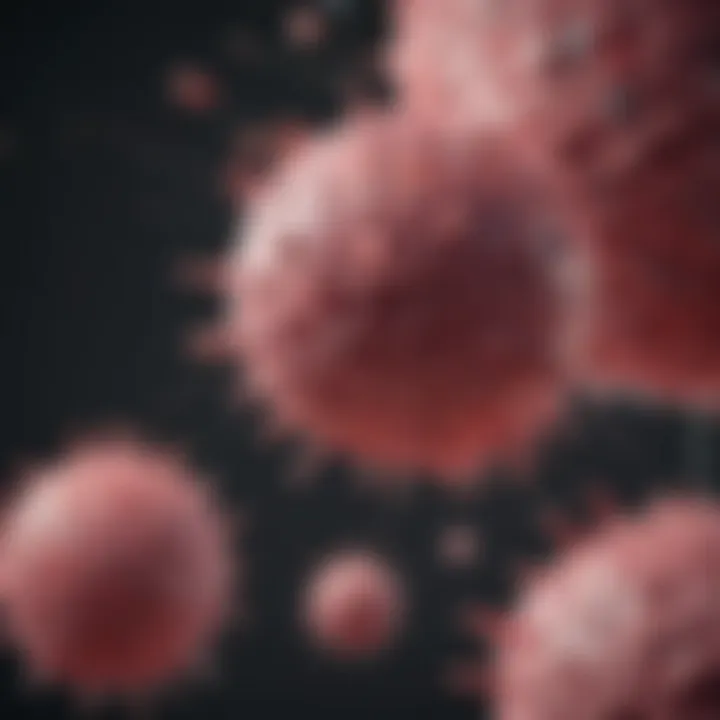Comprehensive Review of Breast Cancer Insights


Intro
Breast cancer is a complex disease that affects millions of individuals worldwide. Understanding its intricacies is critical for both healthcare professionals and patients. This article aims to provide an in-depth analysis of breast cancer, which includes its epidemiology, risk factors, and treatment options, as well as recent advancements in research.
In this review, we will delve into diagnostic methods and emerging therapies such as targeted treatments and immunotherapy. Additionally, we will address the often-overlooked psychosocial implications this disease imposes on patients and their families. Through a structured approach, we attempt to highlight significant findings and their implications for future research and practice.
Key Findings
Summary of the Main Results
Recent studies have indicated that breast cancer's prevalence varies significantly across different populations and regions.
- The risk factors identified include age, family history, genetic predisposition, and lifestyle choices.
- Advances in diagnostic techniques, such as mammography and biopsy methods, have led to early detection, which greatly improves the prognosis.
- Furthermore, the development of precision medicine and tailored therapies, including HER2 targeted agents and hormonal treatments, has transformed patient outcomes.
Significance of Findings Within the Scientific Community
The findings underscore the importance of personalized medicine in treating breast cancer. Surgeons, oncologists, and researchers are increasingly focusing on
- The molecular characterization of tumors.
- Developing appropriate therapies based on individual genetic profiles.
This progression emphasizes collaboration among different disciplines of medicine, enhancing treatment efficiency and overall healthcare quality.
“Personalized treatment options represent a new era in the fight against breast cancer.”
Implications of the Research
Applications of Findings in Real-World Scenarios
The implications of these findings are profound. Understanding risk factors can aid in implementing effective public health strategies aimed at prevention. Moreover,
- Improved diagnostic techniques can lead to earlier interventions, significantly increasing survival rates.
- Novel therapies offer hope for patients with advanced disease, making previously untreatable conditions manageable.
Potential Impact on Future Research Directions
As research continues, we anticipate significant advancements in the following areas:
- Biomarker development for more effective targeting of treatments.
- Improved psychosocial support frameworks for patients.
- Enhanced educational programs for healthcare providers and patients.
Overall, the landscape of breast cancer research is rapidly evolving, bringing new hope and knowledge to the forefront of this important health concern.
Preamble to Breast Cancer
Breast cancer is a critical health issue that affects millions of individuals worldwide. Understanding this disease is essential for both patients and healthcare professionals. In this section, we will outline the significance of breast cancer, its various forms, and how these elements relate to ongoing dialogue in the medical community.
Breast cancer is not merely a medical condition; it has profound social, emotional, and economic implications. Each year, there are considerable advances in treatment and diagnosis. Yet, the impact of breast cancer is felt across all demographics, making it a universally relevant subject.
Definition and Types
Breast cancer refers to malignant tumors that develop from breast tissue. The primary types of breast cancer include:
- Ductal Carcinoma In Situ (DCIS): This is a localized form of cancer where cells inside the ducts do not invade surrounding tissue.
- Invasive Ductal Carcinoma (IDC): This type starts in the breast's ducts and spreads to surrounding tissues.
- Invasive Lobular Carcinoma (ILC): Originates in the lobules and can also spread beyond.
- Triple-negative Breast Cancer: This aggressive type lacks three common receptors, making it more difficult to treat.
Being aware of these classifications aids in understanding treatment options and prognostic factors.
Global Prevalence and Incidence Rates
Breast cancer remains one of the most diagnosed cancers globally. According to recent statistics, it accounts for about 25% of all cancer diagnoses in women. The incidence rates vary significantly by region. For instance, North America reports higher rates compared to countries in Asia.
Here are some key statistics:
- Each year, approximately 2.3 million women are diagnosed with breast cancer.
- Survival rates are generally higher in developed countries, underscoring disparities in healthcare access.
Understanding these trends is crucial. They help focus research efforts and improve treatment accessibility.
"Breast cancer is a leading cause of cancer death in women worldwide, emphasizing the need for effective public health initiatives."
Hence, recognizing the significance of breast cancer goes beyond just numbers. It highlights the necessicity for continued research, better diagnostic methods, and advanced treatment options.
Epidemiology of Breast Cancer
The epidemiology of breast cancer is a crucial area of study that sheds light on how this disease affects populations worldwide. Understanding the patterns, causes, and effects of breast cancer incidence allows researchers and healthcare professionals to develop targeted interventions and prevention strategies. By examining demographic factors as well as geographical variations, we can gain insights into the underlying risk factors and the societal implications of this disease.
Demographic Factors
Demographic factors play a significant role in the epidemiology of breast cancer. Age, gender, ethnicity, and socioeconomic status are key elements that inform the prevalence of this disease. Notably, breast cancer is predominantly seen in women, although men can also be affected, albeit at lower rates.
- Age: Breast cancer risk increases with age, making it more prevalent among older women. The age group of 55 to 64 years shows some of the highest rates of diagnosis.
- Ethnicity: Ethnic background influences breast cancer incidence. For example, Caucasian women have a slightly higher rate of breast cancer compared to African American women, although African American women are more likely to be diagnosed at a younger age and have worse outcomes.
- Socioeconomic Status: Women from lower socioeconomic backgrounds may face higher risks due to reduced access to screening, healthcare, and education about breast cancer.
Additionally, reproductive factors like age at first menstruation, age at first childbirth, and family history also play important roles. These demographic indicators are integral in tailoring breast cancer prevention and early detection initiatives.
Geographical Variations
Geographical variations reveal that breast cancer incidence and outcomes significantly differ across regions and countries. Various influencing factors come into play, such as genetics, lifestyle practices, and healthcare availability.
- North America and Western Europe often report higher incidence rates compared to Asia and Africa. This observation may correlate with lifestyle factors, such as diet and obesity, which is known to be a risk factor for breast cancer.
- Urban vs Rural Areas: Urban populations tend to have more access to healthcare resources and screening programs, leading to earlier detection of breast cancer cases. Conversely, rural populations may experience delays in diagnosis and treatment.
- Cultural Practices: In some cultures, there may be stigma associated with cancer, which impacts awareness and leads to later-stage diagnoses.
"Geographical nuances in breast cancer incidence underscore the necessity for locally tailored health interventions."
In summary, the epidemiology of breast cancer is complex and multifaceted. By exploring demographic and geographical variations, we can better understand the disease and devise strategic public health responses.
This chapter lays the foundation for recognizing how breast cancer affects diverse populations, ultimately guiding research and healthcare policies.


Risk Factors Associated with Breast Cancer
Understanding the risk factors associated with breast cancer is crucial for prevention and early detection. This knowledge allows healthcare professionals and patients to identify potential risks and take proactive steps to mitigate them. By recognizing the various contributors, from genetics to lifestyle choices, one can better appreciate the multifaceted nature of breast cancer.
Genetic and Hereditary Factors
Genetic predisposition plays an essential role in breast cancer risks. This section discusses significant hereditary factors, particularly specific genes that have been extensively studied.
BRCA1 and BRCA2 Genes
The BRCA1 and BRCA2 genes are well-known for their significant linkage to breast and ovarian cancer. Mutations in these genes increase the likelihood of developing breast cancer substantially, with some estimates suggesting a risk increase of up to 80% in carriers. This specific aspect of BRCA1 and BRCA2 is vital as it emphasizes the need for genetic testing for women with a family history of breast cancer.
Key characteristics of BRCA1 and BRCA2 include their role in DNA repair. Both genes help prevent uncontrolled cell growth, which can lead to cancer. Their identification as risk factors has been beneficial for individuals since it opens avenues for preventive measures. Women who are confirmed carriers often opt for enhanced surveillance or preventive surgeries, such as a prophylactic mastectomy, to lower their cancer risk.
One unique feature of BRCA1 and BRCA2 mutation carriers is the psychological impact. Individuals may experience anxiety regarding their cancer risk, complicating their quality of life. This consideration makes discussing genetic testing results essential to improving patient support.
Other Genetic Mutations
In addition to BRCA1 and BRCA2, other genetic mutations also contribute to breast cancer risk. Genes such as TP53, PALB2, and ATM have been identified as significant factors in hereditary breast cancer cases. Studies show that these mutations can also lead to an increased risk of various cancers beyond breast cancer, further complicating the genetic landscape.
The key characteristic of these other mutations is their lesser-known status compared to BRCA genes. While BRCA testing is commonly performed, many women may not be aware of additional genetic factors that increase their risks. This gap in knowledge is important for better breast cancer risk assessment.
Each gene carries unique advantages and disadvantages when it comes to screening and management strategies. The presence of other genetic mutations might necessitate tailored approaches, including variations in surveillance or treatment options for affected individuals. This increased need for personalized medicine underscores the dynamic aspect of understanding breast cancer risk.
Lifestyle and Environmental Factors
Environmental and lifestyle factors significantly influence breast cancer risk as well. By focusing on these aspects, one can empower individuals to make informed choices about their health.
Diet and Obesity
Diet and obesity are critical lifestyle factors influencing the risk of breast cancer. Research indicates that a diet high in saturated fat and low in fruits and vegetables may increase risk. Furthermore, obesity, particularly after menopause, can raise estrogen levels, contributing to cancer development.
The characteristics of diet and obesity make them pivotal in understanding breast cancer. Addressing these factors through lifestyle modification is a powerful preventive strategy. For instance, adopting a balanced diet rich in fiber can help lower the risk.
One unique feature of addressing diet and obesity is the potential for public health initiatives to target these areas for breast cancer prevention. With ongoing awareness campaigns regarding healthy eating, communities can positively influence their members' health outcomes.
Alcohol Consumption
Alcohol consumption is another contributing factor to breast cancer. Studies suggest that even moderate alcohol intake can elevate the risk of developing the disease. The metabolism of alcohol leads to the production of acetaldehyde, a toxic compound recognized as a carcinogen.
The key characteristic here is the dose-response relationship between alcohol and breast cancer risk. Current recommendations suggest limiting alcohol consumption as a precautionary measure. For many, understanding this relationship may lead to lifestyle adjustments, reducing their overall breast cancer risk.
One unique feature regarding alcohol is the societal norms surrounding its consumption. Changing perceptions and promoting lower consumption levels may require significant cultural shifts, potentially impacting the prevalence of breast cancer.
Radiation Exposure
Radiation exposure is recognized as a risk factor, particularly for individuals who have undergone radiation therapy for previous cancers. Those exposed to high levels of radiation, especially during adolescence, may have a heightened risk of developing breast cancer later in life.
The key characteristic of radiation exposure includes its cumulative nature. This means that even low-level exposure over time can accumulate and result in increased risk.
A unique feature of this risk factor is the amalgamation of medical and environmental exposures. There is a need for thorough discussion regarding the necessity and risks of radiation treatments, considering both immediate therapeutic benefits and long-term consequences for breast cancer risk.
In summary, understanding risk factors, including genetic predispositions and lifestyle choices, is crucial in breast cancer prevention. It enables the development of targeted screening strategies and personalized treatment approaches.
Pathophysiology of Breast Cancer
The pathophysiology of breast cancer is fundamental to understanding the complex nature of this disease. It encompasses the biological changes that transform normal breast cells into cancer cells. Insight into these mechanisms can inform treatment strategies and improve patient outcomes. Researchers continue to delve deeper into cellular behaviors, molecular interactions, and how tumors develop and progress. This section outlines key components essential for grasping the breadth of breast cancer pathophysiology.
Cellular and Molecular Mechanisms
Oncogenes and Tumor Suppressor Genes
Oncogenes are genes that, when mutated or expressed at high levels, can lead to cancer. Tumor suppressor genes typically act as regulators of cell growth and division, helping to prevent uncontrolled cell proliferation. Their inactivation is a crucial event in the development of breast cancer.
A notable characteristic of these genes is their contrasting functions: oncogenes promote cell division, while tumor suppressor genes inhibit it. For instance, mutations in the BRCA1 and BRCA2 genes significantly increase the risk of developing breast cancer. These genes are crucial because they maintain genomic stability and repair DNA damage. Inactivation of tumor suppressor genes can lead to genomic instability, contributing to tumor formation.
Therefore, understanding oncogenes and tumor suppressor genes is vital to tailoring targeted therapies that can directly address the underlying genetic abnormalities in breast cancer patients. However, it is not without drawbacks, as targeting these pathways can also lead to adverse effects if not managed appropriately.
Microenvironmental Influences
The tumor microenvironment plays a significant role in breast cancer development and progression. This term refers to the surrounding cells, blood vessels, immune system components, and extracellular matrix that interact with tumor cells. These interactions can either suppress or enhance tumor progression.
A key characteristic of the microenvironment is its supportive role in tumor growth and metastasis. For example, cancer-associated fibroblasts can promote tumor cell proliferation and invasion, thereby facilitating the spread of the disease. This feature makes the microenvironment a popular area of study, as understanding its influence offers therapies that can potentially disrupt these supportive interactions.
The unique aspect of focusing on microenvironmental influences is its multi-faceted nature. Treatments aimed at modifying the microenvironment could complement traditional therapies, potentially reducing side effects and improving efficacy. However, the complexity and variability of the microenvironment pose challenges in devising standardized treatment protocols.
Tumor Histology and Grading
Tumor histology refers to the microscopic examination of cancer cells. It helps in classifying different breast cancer types and understanding their aggressive nature. Histological grading provides insights into the growth patterns and differentiation of the tumor. The World Health Organization classifies breast cancer into several types based on these parameters, including invasive ductal carcinoma and lobular carcinoma.
Grading systems, such as the Nottingham grading system, assess features like tubule formation, nuclear pleomorphism, and mitotic count. This classification informs prognosis and treatment strategies. Higher grades typically indicate a more aggressive disease, necessitating more intensive treatment.
Understanding the histological characteristics can assist clinicians in predicting disease behavior and making informed decisions regarding management strategies.
Diagnostic Approaches for Breast Cancer
Diagnostic approaches for breast cancer are essential in identifying the disease at its earliest stages, which significantly increases the chances of successful treatment and improved survival rates. These methods encompass a range of techniques aimed at detecting abnormalities in breast tissue and accurately diagnosing any presence of cancer. Understanding the most effective diagnostic strategies is crucial for healthcare professionals and patients alike, as early detection can lead to more personalized treatment plans and better outcomes. Additionally, as research advances, these diagnostic techniques continue to evolve, aiming to enhance accuracy, reduce invasiveness, and provide timely interventions.
Screening Techniques
Mammography


Mammography is the most widely used screening tool for breast cancer. It allows for the detection of tumors that may be too small to feel, thus significantly aiding in early diagnosis. The key characteristic of mammography is its ability to produce detailed X-ray images of the breast tissue. For this article, mammography is considered a beneficial choice due to its proven reliability and effectiveness in reducing mortality rates from breast cancer.
A unique feature of mammography is its dual-role capability; it can be used both for routine screening as well as diagnostic purposes when there are symptoms present. Its advantages include the detection of tumors before they become palpable and the ability to evaluate changes in breast tissue over time. However, it is important to note its disadvantages as well, including the possibility of false positives, which can result in unnecessary additional testing, and the discomfort some women may experience during the procedure.
Ultrasound
Ultrasound is another important screening technique that offers complementary information to mammography. This method uses sound waves to produce images of breast tissues, which can help in distinguishing between solid masses and fluid-filled cysts. The key characteristic of ultrasound is its non-ionizing nature, making it a safer option for certain patients, particularly younger women or those with dense breast tissue, where mammography may be less effective.
Ultrasound is a beneficial choice for this article because it provides a clear view of abnormalities identified in mammograms, thus helping to further evaluate suspicious lesions. A unique feature of ultrasound is its ability to be guided by real-time imaging, which allows for precise localization during biopsies. The advantages of ultrasound include its accessibility, cost-effectiveness, and the absence of radiation exposure. However, a disadvantage is that it is generally not recommended as a standalone screening tool, as it does not replace mammography in routine screening practices.
Biopsy Methods and Pathology
Biopsy methods are critical for confirming a breast cancer diagnosis once abnormalities are detected. Various biopsy techniques exist, including fine-needle aspiration, core needle biopsy, and excisional biopsy. Each of these methods has unique indications and effectiveness.
When addressing pathology, it is important to analyze the tissue samples obtained through biopsy. This analysis typically includes looking at the histological type of cancer, grade, and receptor status, which significantly influences treatment options. Accurate pathology reporting is fundamental to ensuring that patients receive the most suitable therapeutic approaches post-diagnosis.
In summary, diagnostic approaches for breast cancer, including mammography, ultrasound, and biopsy, play a vital role in the management of this disease. By utilizing these techniques effectively, healthcare providers can make informed decisions that enhance patient care and outcomes.
Treatment Modalities for Breast Cancer
Treatment modalities for breast cancer play a crucial role in managing the disease and improving patient outcomes. Each method has unique characteristics and applications that cater to different stages and types of breast cancer. The selection of an appropriate treatment strategy often depends on several factors, including the specific characteristics of the tumor, the patient's overall health, and personal preferences. Evaluating these modalities provides insights into the comprehensive approach required in breast cancer treatment, ultimately aiming to enhance survivorship and quality of life.
Surgical Interventions
Surgical interventions are often the first line of treatment for breast cancer. This category encompasses various procedures aimed at removing the tumor and, in some cases, surrounding tissue to minimize recurrence risk.
Lumpectomy
Lumpectomy involves the removal of the tumor along with a margin of surrounding healthy tissue. This technique is known for preserving most of the breast's structure, making it a popular choice among patients who wish to avoid more radical surgeries.
One key characteristic of lumpectomy is its ability to target the cancerous tissue while maintaining the aesthetic shape of the breast. This approach often has a shorter recovery time compared to larger surgeries, facilitating quicker returns to daily activities.
However, lumpectomy is typically accompanied by radiation therapy to eradicate any remaining cancer cells, which adds to the treatment schedule. The effectiveness of lumpectomy is contingent upon early detection, making timely diagnosis essential for favorable outcomes.
Mastectomy
Mastectomy involves the complete removal of one or both breasts, usually recommended for more aggressive or recurrent cancers. The primary goal is to eliminate the entire tumor mass and reduce the likelihood of metastasis.
A notable feature of mastectomy is that it can be performed as total mastectomy or partial, depending on the extent of the disease. This approach is sometimes necessary when tumors are large or multifocal.
While mastectomy can offer peace of mind regarding cancer recurrence, it is an invasive procedure with a longer recovery period and significant implications for body image. Patients often face emotional challenges post-surgery, requiring support and guidance as they adjust to changes in their physical appearance.
Radiation Therapy
Radiation therapy is a non-invasive treatment used post-surgery or when surgery is not an option. The goal is to destroy cancer cells in the treated area, reduce the risk of recurrence, and alleviate symptoms in advanced cases.
This treatment is critical in minimizing the chance of local recurrence, especially after a lumpectomy. It can also be used in combination with mastectomy, depending on the patient's specific situation. The targeted nature of radiation allows for precision, but patients may experience side effects such as fatigue and skin irritation.
Systemic Therapy
Systemic therapy uses medications that travel through the bloodstream to reach cancer cells throughout the body. This approach is vital for treating breast cancer, especially when the disease is considered systemic or has spread beyond the primary site.
Chemotherapy
Chemotherapy employs cytotoxic drugs aimed at eliminating rapidly dividing cells, which include cancerous cells. It is recommended most often for patients with larger or more aggressive tumors, and it may be used pre- or post-surgery.
A key characteristic of chemotherapy is its potential to shrink tumors before surgery, allowing for less extensive surgical options. Despite its effectiveness, chemotherapy has well-known side effects, including nausea, hair loss, and compromised immune function, which can affect patients' quality of life during treatment.
Targeted Therapy
Targeted therapy focuses on specific molecular targets associated with cancer. For trastuzumab, for example, the treatment is effective against tumors expressing the HER2 protein. This approach offers a more tailored strategy, thus minimizing damage to healthy cells compared to traditional chemotherapy.
The significant advantage of targeted therapy is its precision, often translating to fewer side effects and better outcomes. However, it may not be suitable for all breast cancer types, necessitating thorough genetic testing and evaluation.
Immunotherapy
Immunotherapy empowers the immune system to recognize and combat cancer cells. This treatment has emerged as a promising frontier, especially for patients with triple-negative breast cancer, a more challenging subtype to treat.
A notable feature of immunotherapy is the use of checkpoint inhibitors, which unblock pathways that cancer uses to evade the immune system. While immunotherapy holds great promise, it can lead to immune-related side effects, requiring careful monitoring and management.
In summary, understanding the various treatment modalities for breast cancer assists in comprehending the complexities of the disease management. Each approach carries its merits and challenges, and patients must work closely with their healthcare teams to determine the most appropriate strategy tailored for their unique circumstances.
Current Research and Advances in Breast Cancer
Breast cancer research is essential as it sheds light on treatment options and enhances survival rates. Understanding the current advances can provide vital information for clinicians. It paves the path for medical professionals and scientists to develop more effective therapies. The significance of targeted therapies and immunotherapy cannot be overstated. They open up new avenues in managing the disease while minimizing side effects.
Innovations in Targeted Therapies
Targeted therapies represent a paradigm shift in the treatment of breast cancer. Unlike traditional methods, these therapies aim for specific genetic markers or proteins associated with cancer cell growth. This precision allows for a more personalized approach to treatment. For instance, drugs such as trastuzumab target the HER2 protein, which is overexpressed in some breast cancer subtypes.
These therapies often result in reduced toxicity compared to standard chemotherapy, making them a preferred choice for many patients. Additionally, ongoing research continues to identify novel targets, broadening the scope of effective treatment options.
Emerging Trends in Immunotherapy
Immunotherapy leverages the body's immune system to fight cancer cells. Recent advances in this field focus on innovative treatment strategies that enhance immune response specifically against breast cancer.
Checkpoint Inhibitors
Checkpoint inhibitors are a revolutionary approach in immunotherapy. They work by blocking proteins that inhibit the immune response. This action allows T-cells to recognize and attack cancer cells more effectively. The key characteristic of checkpoint inhibitors is their ability to enhance immune surveillance. This method has become a popular choice for specific breast cancer subtypes, particularly triple-negative breast cancer.
Advantages of checkpoint inhibitors include a relatively favorable side effect profile compared to conventional therapies. However, disadvantages may involve challenges in predicting which patients will benefit the most. Additionally, not all patients respond positively to this treatment, which emphasizes the necessity for personalized treatment planning.


CAR T-Cell Therapy
CAR T-Cell Therapy represents another innovative approach in the landscape of immunotherapy. This method involves modifying a patient's T-cells to better attack cancer cells. The key trait of CAR T-Cell Therapy is its customization, allowing the immune system to specifically target cancer-associated antigens.
The unique feature of CAR T-Cell Therapy lies in its potential for high efficacy in some patients with aggressive tumors. However, it is important to note the challenges involved, including the possibility of severe side effects like cytokine release syndrome. There is also a need for thorough monitoring post-treatment.
"Current research is pushing the boundaries of what is possible in treating breast cancer, revealing pathways that were previously unexplored."
These advances, particularly in targeted therapies and immunotherapy, signify hope for better treatment outcomes. Each development not only enhances understanding but also cultivates a more nuanced approach to managing breast cancer.
Psychosocial Aspects of Breast Cancer
Understanding the psychosocial aspects of breast cancer is crucial for a holistic approach to treatment and recovery. This section highlights how the diagnosis and treatment of breast cancer affect patients not just physically but also emotionally and socially. The importance of recognizing these elements lies in improving the overall quality of life for patients, which can significantly influence their treatment outcomes. Patients often face emotional distress, changes in body image, and the re-definition of their roles within families and society. Thus, addressing these psychosocial aspects is fundamental in providing comprehensive care.
Emotional and Psychological Impact
The emotional and psychological impact of breast cancer can be profound and multifaceted. Many patients experience anxiety, depression, and feelings of vulnerability upon receiving a diagnosis. Factors such as the nature of the disease, treatment side effects, and concerns about recurrence all contribute to heightened emotional strain. Moreover, studies have shown that addressing emotional health not only benefits mental well-being but can also positively influence physical health.
- Common Emotional Responses:
- Anxiety about treatment and outcomes.
- Depression due to changes in life and health status.
- Body image issues arising from surgeries or treatment effects.
Patients may benefit from counseling and support systems that cater to these emotional needs. Strategies such as mindfulness and cognitive behavioral therapy can provide tools for managing these challenges.
Support Systems and Resources
Support systems play an essential role in the recovery process for breast cancer patients. Having a network that includes family, friends, healthcare professionals, and support groups can alleviate feelings of isolation. These resources can provide encouragement and practical advice during a challenging time.
Counseling and Therapy
Counseling and therapy serve as a fundamental resource for patients coping with the emotional ramifications of breast cancer. These sessions can offer a space to express fears and concerns, allowing for emotional processing. The key characteristic of counseling is the individualized attention and tailored support it provides.
- Benefits:
- Helps in addressing specific emotional issues like anxiety or depression.
- Provides coping strategies tailored to individual needs.
A unique feature of therapy is that it can adapt to different patient needs, whether through one-on-one sessions or group therapy. Though effective, some may find it challenging to initiate or remain consistent with counseling.
Support Groups
Support groups are another significant aspect of available resources for breast cancer patients. They create a sense of community among individuals who share similar experiences, which can be comforting and educational. The key characteristic of support groups is the collective sharing of experiences and mutual encouragement among members.
- Advantages:
- Offers a platform for shared learning and emotional support.
- Reduces feelings of isolation through shared understanding.
While support groups can be very beneficial, the dynamics may vary. Some members might prefer personal stories over professional advice, making it essential to find the right group fit. Overall, both counseling and support groups form a comprehensive support system that enhances the psychosocial framework necessary for patient recovery.
Post-Treatment Considerations
Post-treatment considerations are vital to understanding the journey of breast cancer patients after their medical treatment has concluded. These elements influence not only the physical recovery but also the psychological and emotional health of survivors. It is essential to comprehensively address survivorship and follow-up care, as well as rehabilitation and quality of life, to help patients navigate this crucial phase.
Survivorship and Follow-Up Care
Survivorship encompasses the experiences of individuals who have completed primary cancer treatment. It represents a significant transition in the life of a patient. Follow-up care plays an essential role in monitoring for any recurrence of cancer and managing long-term side effects from treatment. Regular medical assessments can involve physical examinations and imaging tests tailored to detect potential issues early. This proactive approach promotes faster responses to any complications, leading to better patient outcomes.
Psychological support is equally important. Many survivors face anxiety, fear of recurrence, or depression. Addressing these emotional aspects can be achieved through counseling and support groups, which offer platforms for sharing experiences and coping strategies. Initiatives that focus on holistic care, integrating both medical follow-ups and mental health resources, can significantly enhance the quality of life for survivors.
Rehabilitation and Quality of Life
Rehabilitation after breast cancer treatment is integral to restoring physical and emotional well-being. Possible physical issues resulting from surgery, radiation, or chemotherapy include fatigue, lymphedema, and changes in physical appearance. Personalized rehabilitation programs focusing on exercises can alleviate these concerns. Engaging in physical activity has shown benefits for stamina and strength, which in turn boosts emotional resilience.
Quality of life extends beyond physical recovery. Survivors often seek to regain a sense of normalcy. This can involve engaging in hobbies and social activities that enrich life. Support systems, like friends and family, contribute greatly towards recovery.
"A successful post-treatment framework includes both medical and emotional support to fight against the residual effects of treatment and to inspire hope and healing."
Patients, healthcare professionals, and researchers must collaborate to ensure continued support in these areas.
Keywords:
- Survivorship
- Follow-up care
- Rehabilitation
- Quality of life
- Breast cancer survivors
For more insights, visit Wikipedia.
Closure and Future Directions
The conclusion of this comprehensive evaluation of breast cancer encapsulates the myriad of insights gained about this pervasive disease. One cannot underestimate the critical importance of understanding breast cancer, from its onset to treatment modalities and the psychosocial ramifications that arise. With the statistics on prevalence and incidences shifting continually, it is essential to keep abreast of new findings and emerging trends in research and treatment. This article is an attempt to synthesize current knowledge while also suggesting areas for future inquiry.
The future directions highlighted in this article focus on advancing novel therapeutic approaches, which show promise for improving patient outcomes. Innovations in targeted therapies and genetic research present a fertile ground for further exploration. Additionally, understanding the interconnectivity of environmental, lifestyle, and genetic factors could revolutionize prevention and treatment protocols, thus shaping a holistic approach to breast cancer management.
"The exploration of innovative therapies is becoming central to improving quality of life for breast cancer patients."
Such developments warrant attention from researchers, practitioners, and policymakers alike. The implications extend beyond mere data; they reflect a collective aspiration to enhance survivorship and support for affected individuals. A thorough understanding and continued discourse on the psychosocial aspects of breast cancer are equally vital. These elements are integral to forming effective support networks and patient resources, ensuring that individuals receive not just clinical care but also emotional and mental health support.
Ultimately, as we analyze our findings and the current landscape of breast cancer, the call for further research becomes all the more imperative. Delving deeper into the intersections of various influences can open doors to future breakthroughs and significantly improve patient outcomes.
Summary of Key Points
In this article, several key points have emerged regarding breast cancer:
- Understanding Varied Factors: The intricate interplay of genetics, lifestyle, and environmental factors underlines the complexity of breast cancer.
- Diagnostic and Therapeutic Advances: Innovations in diagnostic methodologies and treatment options like immunotherapy and targeted therapies are reshaping patient management.
- Psychosocial Considerations: Recognizing the emotional burden that breast cancer places on patients and building effective support systems is crucial.
- Continued Research Focus: There is a need for ongoing research to inform best practices and update clinical protocols.
Each of these points contributes to a broader understanding of breast cancer and emphasizes the need for a multi-faceted approach to combat this disease effectively.
Implications for Future Research
Breast cancer research is at a pivotal juncture. As we look forward, the implications for future inquiry are substantial:
- Targeted Therapies: Emphasizing the development of personalized medicine can lead to more effective treatment options tailored to individual patient profiles.
- Genetic Research: Digging deeper into genetic mutations such as those beyond BRCA1 and BRCA2 can uncover new risk factors and therapeutic targets.
- Lifestyle Modifications: Extensive studies investigating the influence of diet, exercise, and exposure to toxins on breast cancer risk can guide preventive strategies.
- Patient-Centric Studies: Exploring patient experiences can enhance understanding of quality of life issues, informing support systems and rehabilitation programs.







